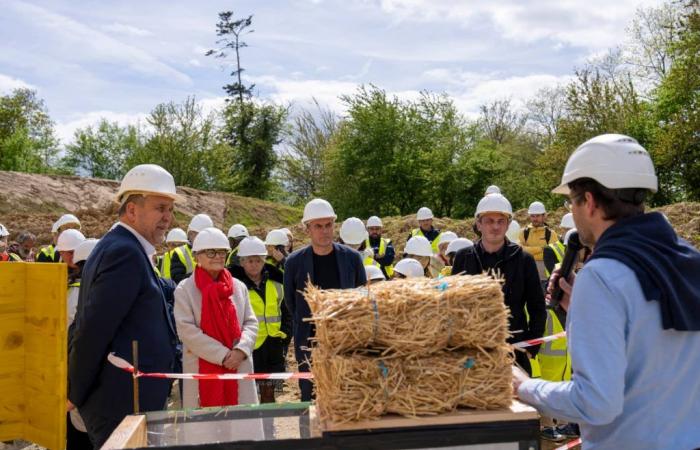The construction sector is responsible for 23% of greenhouse gas (GHG) emissions in France. To limit the rise in temperatures to 2°C by the end of the century, the building sector must also reduce its use of fossil fuels. And therefore change its model, without neglecting the needs of the territory in terms of housing, infrastructure and activities. However, the increase in the population of Rennes Métropole, estimated at 533,500 inhabitants in 2035, requires the creation of 65,000 new housing units. Demand is particularly strong in the social housing sector. But not everything is possible anymore. Through the objective of Zero Net Artificialization (Zan*), the law requires the preservation of existing agricultural land and natural spaces, while promoting biodiversity. With land becoming increasingly scarce and global warming increasingly present, low-carbon construction is becoming an obvious choice.
(*Principle of land use planning according to which any artificialization of land must be compensated by the creation – restoration of natural, agricultural or forest areas.)
Sustainable design
But how to do it? A successful eco-construction operation begins with choosing its location. A good site allows solar energy to be captured in winter and cooled in summer. A bioclimatic design limits energy needs and maximizes comfort. The orientation of the building is essential, but so is its location. Proximity to jobs, services and public transport reduces travel.
Around buildings, planting trees, digging swales (wide and shallow ditches) and favoring draining paving stones, all this facilitates the infiltration of water into the ground. The search for energy savings is also essential. To do this, we are trying to move towards passive buildings, i.e. neutral in terms of energy consumption, with the help of renewable energies such as biomass or photovoltaics.
Sustainable construction also encourages us to think about the evolution of our uses. We must anticipate by integrating the reversibility of buildings. Well designed, an office building can be transformed into a rental residence a few years later. It’s all a question of dimensions, heights, load-bearing walls, false floors, continuous balconies, etc.
Recycle what already exists
But should we build at all costs? Building low carbon also means, and above all, making do with what already exists. This is called “urban recycling”. And hunting down lost or useless square meters takes several forms.
Maximize the use of buildings by opening them to different audiences over extended time slots. Mobilize vacant housing. Convert offices into apartments. Transform brownfield sites. Raise buildings…
The Rennes Métropole Local Housing Programme (PLH) plans for 10% real estate recycling by 2028. The transformation of the Hôtel-Dieu and the Hôtel Pasteur in Rennes are examples of this.
Renovate “nature”
Having less impact than demolition-reconstruction, renovation is the other low-carbon alternative. According to the Ecological Transition Agency (ADEME), the new construction of a collective housing building requires 80 times more resources. Hence the decision in Maurepas by Archipel Habitat to completely rehabilitate the ten towers of Gros-Chêne. A titanic project that combines quality of life and energy performance.
Building low carbon also means thinking about reuse. While the vast majority of them could be, only 1% of materials from deconstructions are actually reused in France. Steel beams, wooden frames, PVC frames… For an identical use but in a different environment, the reuse of materials in their initial form – or barely transformed – represents a considerable carbon gain. And no need to go far, the Rennes basin has its nuggets like the companies Bâti’Récup or Bluemarket…
The implementation of bio-sourced materials is the last piece of the puzzle. Their list is long. Available in panels, rolls, bricks or bales, they are wood, hemp, cork, straw, raw earth… But also algae, thatch, flax, cellulose wadding or recycled textiles. Their environmental footprint is low, especially when they are local and little processed. Combining these eco-materials, sometimes more expensive, with conventional materials also allows you to control your budget. Knowing how to use the strengths of different materials by combining them, so that they work together, is the logic of the right material in the right place!
Examples of eco-construction in the metropolis
Ecoconstruction: The new school group under construction in Mordelles.
The laying of the first “earth” took place in April. The 14 classes will be housed in buildings mainly constructed of load-bearing raw earth, wood and straw. An opportunity to renew the link with the agricultural world by using local raw materials.
Second life: Élan Bâtisseur in Saint-Jacques-de-la-Lande
The cooperative set up shop in a disused warehouse, transformed from floor to ceiling by its salaried contractors, with storage boxes, rental equipment and convivial spaces. Apart from the plumbing and asbestos removal, the craftsmen carried out the work themselves. At the heart of the project: eco-materials such as the wooden frame, the earth-straw mixture for the wall separating the workshops from the offices, wood wool insulation, foundations insulated with cork balls and cellulose wadding, made from recycled paper. The floor? Cork. The partitions between the offices? Recycled cotton textile provides sound insulation. In terms of reuse, the reception desk and workshop windows come from the renovation of the Néotoa head office.
A guide to promoting sustainable construction
Rennes Métropole has published a methodological guide to promote sustainable construction. The low-carbon energy reference defines the requirements applicable to new construction projects in public development operations since January 1, 2023.
This reference document indicates technical criteria, performance indicators, obligations of means and results. It sets out a body of binding rules in order to reduce the carbon impact of new construction on its life cycle and energy consumption.






